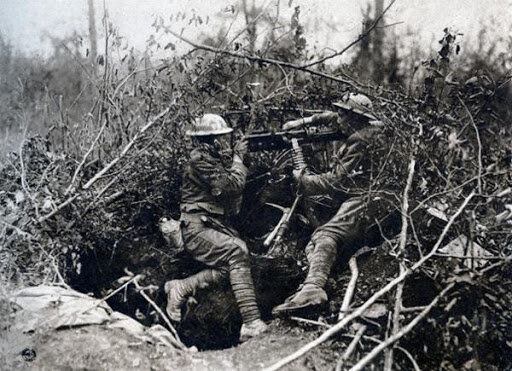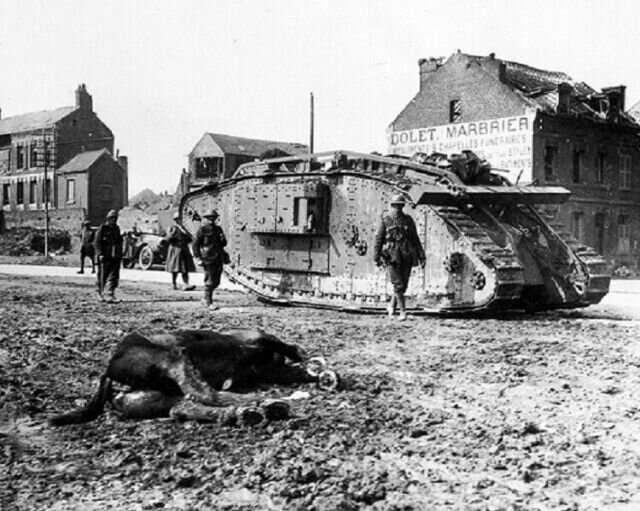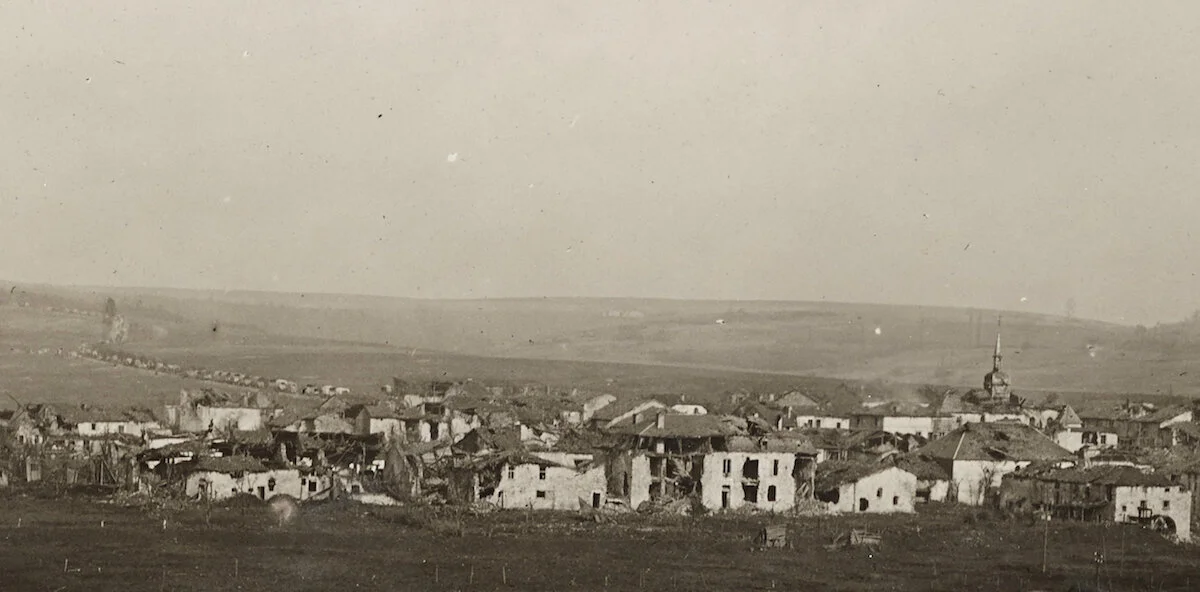WALKWAY OF SORROW TO BANTHEVILLE
Texan Scott Murphey came to France to walk in his grandfather’s footsteps of the First World War. ‘I tried to imagine what it was like when he was there. The ditches were filled with dead bodies.’
by Cor Speksnijder
Edgar Jewell Womack- Mar 19, 1896 - Jan 7, 1975
On a damp November day in northern France, U.S. Army Private Edgar Womack, a 22 year old apprentice-tailor from Texas, struggled to make his way against the flow of an endless convoy of soldiers, trucks and horses that moved towards the front. Severely weakened by dysentery, every meter was a torment and he had to stop frequently to rest in the roadside ditch.
Sometimes he lost consciousness. It took him all day to walk just three kilometers from Aincreville to the American ambulance station in Bantheville. Walking the road to Bantheville was the longest day of his life.
Womack arrived in Europe in 1918. He was one of two medical aidmen who were embedded in the 359th’s Company D of the 90th Infantry Division. The 90th – known as the Alamo Division - was part of the larger million-man American Expeditionary Force that was pushing back the German troops on the western front. The two aidmen followed behind the battle, established temporary aid stations, stopped wounds from bleeding, put splints on shattered bones, identified the wounded and marked the dead.
The 90th Infantry Division in action, Meuse-Argonne 1918
In the early morning of November 1st, the Americans started attacking German positions near Bantheville. Among the doughboys were 150 men from Company D, who were mainly Texan farmers’ sons. The 345th Machine Gun Battalion shot more than two million bullets over their heads to cover the 359th’s advance towards Villers-devant-Dun. The attack was successful - the Americans made more progress than expected.
During the advance Womack provided first aid in shell craters, at night he helped to set up an aid station in a building behind the church in Aincreville. Womack and other aidmen attended to the wounded before their transfer to a hospital by ambulance. A back room that became a morgue quickly filled as there were over 750 division casualties that day. It was one of the bloodiest days in the Meuse Argonne Offensive, the bloodiest battle in American history.
Americain soldiers amidst the ruins of the church of Aincreville 1918
Still from a short film 1918. The view is looking due north to Aincreville. You can clearly see the traffic jam exiting Aincreville going north on the Aincreville-Villers devant Dun Road. The buildings hide the traffic jam as it goes through town and turns north.
The same still, digitally colored by Scott Murphey
Womack got sick. He had amoebic dysentery from eating meat of dead horses when the food supply fell short. He was too weak to carry on with the advancing troops and was ordered to evacuate to the ambulance station in Bantheville. On foot. In the morning of November 3rd, he started the grueling walk that would take ten hours and mark the end of his role in the First World War. He was evacuated from Bantheville to a hospital in Nantes, from where he was repatriated.
Scott Murphey in the footsteps of his grandfather walking the Aincreville- Banthevill road in 2018
Exactly hundred years later, on November 3 in 2018, Womack’s grandson Scott Murphey walked in his footsteps on the road to Bantheville. To honour his grandfather he carried his WWI helmet and he left little Texan flags along the way. What was a horrible march for the young Womack turned out to be an easy walk for Murphey, taking him only half an hour. The time difference underlined the suffering of his grandfather. ‘I tried to imagine what it was like when he was there’, says Murphey in a video meeting. ‘The road was jammed, the ditches were filled with dead bodies.’
Scott’s pilgrimage. The road from Aincreville to Bantheville. At the bottom Romagne with the Meuse-Argonne Cemetery to its right
Montsec Americain Monument in the Saint Mihiel salient photo © Diederik van Vleuten
Bugler
Edgar Womack never wanted to be a soldier. He tried to dodge the draft and said he had a hernia and had to take care of his father. It didn’t work. Initially assigned to be the company bugler, he was able to transfer to the Medical Department because he said ‘saving a life appealed to me more than taking one’. After a short training in England he was sent to France, where his unit was deployed at Saint Mihiel, south of Verdun.
After a short but fierce battle his company went north, towards Romagne, where the Meuse Argonne Offensive was in progress. For three atrocious days he was part of that massive operation.
In June 1919 he returned to his hometown Corsicana, Texas with 60 dollars from the army in his pocket. He started a menswear business with his brother called Womack Brothers.
When Womack married a Texas sheriff’s daughter in 1920, an army buddy was his best man. ‘Edgar saved the life of Curtis Cunningham, a corporal who inhaled gas at Saint Mihiel’, says Murphey. ‘They were bonded for life.’
Montsec Americain Monument in the Saint Mihiel salient photo © Diederik van Vleuten
Womack’s dysentery had a long lasting effect on his health. He had to have special meals, years and years after the war. He spoke sparingly about his experiences in France. But when the young Murphey helped his grandfather in his orchard and sold peaches along the road with him, the stories came.
Murphey: ‘He told me at Saint Mihiel that wounded boys in no man’s land would cry out in pain all day, while he couldn’t do anything to help them. He had to crawl out of the trench at night to get them back and nurse them. He remembered how soldiers would cry out for their mother when they died in his arms. When he told this, 50 years after the war, he couldn’t hold back his tears. He always told me there’s nothing glorious about war.’
Ku Klux Klan Parade at Waco, about 60 miles south-west of Corsicana. 1924
After the Great War: Ku Klux Klan
Murphey cherishes the memory of his grandfather, who died in 1975. His doughboy helmet has a prominent place in his living room, together with a big brass cash register that used to be in the Womack Brothers store.
The register symbolizes Murphey’s grandfather’s second battle: resisting pressure to join the Ku Klux Klan -– a powerful organization that rose to prominence after the war in the southern United States promoting violence, hate and intolerance. His refusal to join caused the president of the local bank, a high ranking Klansman, to cancel his business loan.
He lost the entire store and his livelihood, but he managed to keep the store’s cash register that Murphey would later operate selling peaches with his grandfather. ‘These two objects remind me of a remarkable man who went to war to save lives in battle instead of taking them, and who entered yet another battle to respect lives instead of diminish them when he returned home. Both battles left an indelible lifelong imprint on him that has transferred to me.’
Familiy history at its best. The helmet of Edgar Womack and the original cash register that used to be in the Womack Brothers store.
Scott Murphey (62) is an architectural historian for the United States Army. He visited the former battlefields and the museum in Romagne twice, in 2018 and in 2019. It strikes him that hardly anything had changed around Romagne in a hundred years. Compared to old pictures the roads are still the same, the buildings are still where they used to be, destroyed houses were rebuilt. In Aincreville he called at the house behind the church where his grandfather established an aid station. He surprised the French residents with a fruitcake from Corsicana.
Edgar Womack and his grandson Scott Murphey
Murphey greatly appreciates the collection that Jean-Paul de Vries has assembled in his museum. ‘One helmet means something for me because it belonged to my grandfather. When you look at all the many objects that Jean-Paul has collected, the overwhelming mass of these personal items of war imparts the feeling of what really happened there and connects you to a specific place. The fact that all objects are from the area around Romagne gives the collection an extra dimension. The museum keeps the artifacts in their context – and as a historian I always emphasize that context is everything to understand history. If Romagne 14-18 was in Paris, the museum would not even be close to the same experience. The museum doesn’t only show military history - it directly connects us to the soldiers – the countless Edgar Womacks on both sides - who bled, who lived and who died on soil around Romagne and profoundly shaped the world we live in today.’
Young visitor of Museum Romagne 14-18 with an American helmet photo © Diederik van Vleuten















